By the Numbers
South Korea’s export slump eases as external demand improves
Bloomberg | July 31, 2020 | International Trade | By The Numbers
South Korea’s export slump slowed in July, aided by the economic recovery in China and resilient demand for semiconductors.
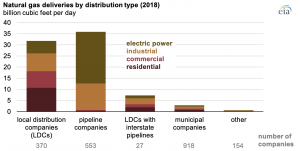
U.S. homes and businesses receive natural gas mostly from local distribution companies
AJOT | July 31, 2020 | Energy | Conventional | By The Numbers
According to the U.S. Energy Information Administration’s (EIA) Natural Gas Annual Respondent Query System, 2,022 natural gas delivery companies delivered natural gas to end-use customers in the United States in 2018.
IAG Cargo releases Q2 results
AJOT | July 31, 2020 | Air Cargo | Airlines | By The Numbers
IAG Cargo today announced its Q2 2020 results, reporting commercial revenues of €369m over the period from April 1 to June 30, 2020, an increase of 33.1 per cent on the same period in 2019 at constant currency.

US freight levels see rapid v shaped recovery after COVID shutdown
AJOT | July 27, 2020 | Intermodal | Shipping Technology | Trucking | By The Numbers
The US economy has been striving for recovery since the onset of the COVID-19 pandemic which struck hardest during the month of March.
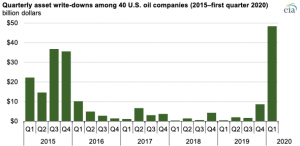
Early 2020 drop in crude oil prices led to write-downs of U.S. oil producers assets
AJOT | July 27, 2020 | Energy | Conventional | By The Numbers
According to publicly filed financial statements, 40 U.S. oil producers collectively wrote down $48 billion worth of assets in the first quarter of 2020, the largest quarterly adjustment since at least 2015.
Rystad Energy’s daily market comment from our Head of Oil Markets Bjornar Tonhaugen
AJOT | July 24, 2020 | Energy | Conventional | By The Numbers
Oil prices lost some of their currency gains in yesterday’s late trading session and the trend continues this morning, with both Brent and WTI facing a modest decline.
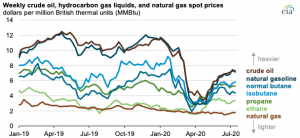
Hydrocarbon gas liquids spot prices are generally bound by crude oil and natural gas
AJOT | July 22, 2020 | Energy | Alternative | By The Numbers
Source: U.S. Energy Information Administration, based on Bloomberg, L.P. The combination of rapidly declining crude oil prices in March 2020 and relatively flat (and historically low) natural gas prices compressed hydrocarbon gas liquids (HGL) spot prices into a narrow price band from mid-March through the end of April 2020. This relatively narrow band has since widened as crude oil prices have increased and natural gas prices have remained low. Generally, HGL prices are based on their heat content and are bracketed by the prices of natural gas (the lower bound) and crude oil (the upper bound). The heat content of a fuel reflects the amount of heat energy released by the combustion of a physical measure of energy, such as a barrel or cubic foot. The U.S. Energy Information Administration’s (EIA) Monthly Energy Review provides information on the heat content of various fuels, including all HGLs. For example, ethane, the lightest HGL, has an approximate heat content of 2.8 million British thermal units (Btu) per barrel. Ethane generally costs about as much as natural gas on a heat-content equivalent basis. Ethane has two carbon atoms, which is one more carbon atom than methane—the primary constituent of natural gas. The supply of ethane has grown more rapidly than the petrochemical industry's ability to consume it as a feedstock. The remaining supply is left in the natural gas stream (a process referred to as ethane rejection), which tends to slightly increase the heat content of a cubic foot of natural gas. Propane, the second-lightest HGL, which has three carbon atoms, has trended closer to other petroleum products because it can easily be substituted for other fuels for such uses as space heating, transportation, or petrochemical feedstock. A surplus of U.S. propane and high transportation costs to reach export markets have discounted U.S. propane compared with other petroleum products and international propane markets. Heavier HGLs typically are priced closer to crude oil. Normal butane and isobutane are widely used in motor gasoline blending in the winter and to produce high-octane gasoline blending components. Natural gasoline, the heaviest HGL, has at least five carbon atoms and can be blended into motor gasoline throughout the year or blended with ethanol as a denaturant (which makes the ethanol unfit for human consumption). Because natural gasoline is a liquid at ambient temperature and pressure, it can more easily be shipped overseas. Natural gasoline is often priced close to crude oil on a heat content basis. Principal contributors: Joshua Eiermann, Warren Wilczewski
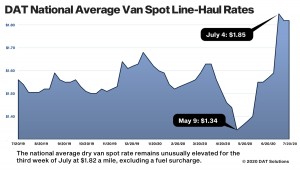
DAT Spot Truckload Market Summary, Week Ending July 19
AJOT | July 22, 2020 | Intermodal | Trucking | By The Numbers
Rates have moved higher week over week since the start of July, an unusual pattern as volumes tend to diminish and dry van capacity typically loosens from now through to early October.
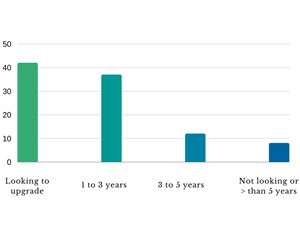
Pandemic business practices accelerate freight digitalization
AJOT | July 22, 2020 | Shipping Technology | By The Numbers
The coronavirus pandemic is proving a catalyst for shipping digitalization, prompting ocean supply chain stakeholders to abandon manual processes and embrace automated transport management solutions to drive business growth, according to a new survey by Haven Inc.
Rystad Energy’s daily market comment from our Head of Oil Markets Bjornar Tonhaugen
AJOT | July 22, 2020 | Energy | Conventional | By The Numbers
Oil prices are declining today but it’s not much of a surprise if one thinks that Brent hit new Covid-19 highs yesterday, in the same day that API reported an unexpected massive weekly stock build. A correction was due and we can see it in today’s market.

ATA Truck Tonnage Index Jumped 8.7% in June
AJOT | July 21, 2020 | Intermodal | Trucking | By The Numbers
American Trucking Associations’ advanced seasonally adjusted (SA) For-Hire Truck Tonnage Index increased 8.7% in June after falling 1% in May. In June, the index equaled 115.3 (2015=100) compared with 106.1 in May.

More than 60% of energy used for electricity generation is lost in conversion
AJOT | July 21, 2020 | Energy | Conventional | By The Numbers
In 2019, U.S. utility-scale generation facilities consumed 38 quadrillion British thermal units (quads) of energy to provide 14 quads of electricity. Most of the difference between these values was lost as an inherent result of the energy conversion process.
Kuehne+Nagel manages the crisis successfully
AJOT | July 21, 2020 | Logistics | By The Numbers
In light of the challenges posed by the coronavirus pandemic and the global lockdown, the Kuehne+Nagel Group achieved a good result in the second quarter of 2020. Market share gains and the cost savings initiated throughout the Group had a positive impact.
Report: 3 out of 4 supply chains adversely affected by COVID-19
AJOT | July 20, 2020 | Logistics | Integrators | By The Numbers
The latest BCI report, COVID19: The Future of Supply Chain, shows the devastating impact the pandemic has had on supply chains, with 73% of organizations encountering ‘some’ or ‘significant’ detrimental effect on the supply side.
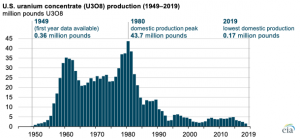
U.S. uranium production fell to an all-time annual low in 2019
AJOT | July 17, 2020 | Energy | Alternative | By The Numbers
The United States produced 174,000 pounds of uranium concentrate (U3O8) in 2019, 89% less than in 2018 and the lowest amount produced since the U.S. Energy Information Administration’s (EIA) data series began in 1949. Domestic U3O8 production has declined since its peak of 43.7 million pounds in 1980.
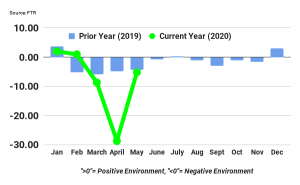
FTR’s May Trucking Conditions Index bounces back sharply from April low but still negative
AJOT | July 17, 2020 | Intermodal | Trucking | By The Numbers
FTR’s Trucking Conditions Index reading for May rebounded from its worst-ever level in April to a reading of -5.19. While much improved, May’s reading is quite negative from a historical perspective. A sharp increase in freight was primarily responsible for the improvement as rates and utilization were still weak.
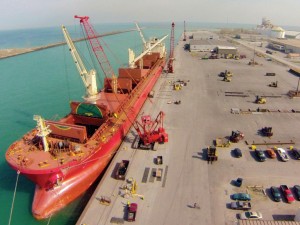
Uptick in traditional cargos & steady international shipments moving on St. Lawrence Seaway
AJOT | July 16, 2020 | Maritime | Breakbulk News | By The Numbers
American ports in the Great Lakes-St. Lawrence Seaway system handled a diverse mix of inbound and outbound cargos from 20 countries through June, reporting strong activity with wind energy components as well as traditional Seaway cargos. Year-to-date total tonnage—from the opening of the St. Lawrence Seaway on April 1, 2020 through June 30, 2020—increased to 11.7 million metric tons (mt), down 8.4 percent compared to this time last year.

Fraport Passenger Numbers Remain at Very Low Levels
AJOT | July 13, 2020 | Air Cargo | Airports | By The Numbers
Frankfurt Airport and Fraport’s Group airports worldwide see substantial year-on-year decline in passenger traffic – June shows slight improvement from May
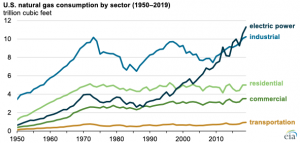
In 2019, the United States produced and consumed record volumes of natural gas
AJOT | July 10, 2020 | Energy | Conventional | By The Numbers
Natural gas is one of the main sources of energy in the United States. In 2019, U.S. production of dry natural gas increased to almost 34 trillion cubic feet (Tcf) and consumption increased to 31 Tcf—both values were records.
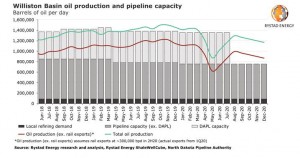
If DAPL pipeline shuts down, hundreds of thousands of US oil barrels will lack an exit route in 2020
AJOT | July 10, 2020 | Energy | Conventional | By The Numbers
A US district court has ruled that the largest outbound Bakken pipeline – the Dakota Access Pipeline or DAPL – shall be emptied within 30 days. If this decree remains in place, hundreds of thousands of produced barrels per day will lack an export route in 2020, Rystad Energy estimates, as alternative options such as other existing pipelines or railway transportation will not be able to fully take on the burden until next year.
© Copyright 1999–2025 American Journal of Transportation. All Rights Reserved
